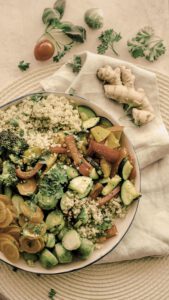Affiliate Disclosure
Some of the links on this page may be affiliate links. As an Amazon Associate, I earn from qualifying sales from these links. If you make a purchase or sign up for a membership through these links, I will receive a small commission. This will not cause any additional costs for you. This income helps us to run this website and especially the blog for you.
The fast-food problem
Surely this statement is no surprise to you, but I have to remind myself again and again how important a wholesome, healthy diet is. Because what you eat every day becomes the components for our cells.
On days that are very stressful, I sometimes forget to eat regularly. Unfortunately, this is often reflected in circulatory problems and concentration deficits.
My go-to “fast food” on one of my working days in the home office, for example, is a slice of wholemeal bread with a plant-based spread. This lunch fills you up in the short term and is quick to prepare, but in the long run it does not provide enough protein and nutrients. Since I work exclusively in my home office, I don’t have typical canteen food. For others, it might be the curry sausage from the food stall right next to the office.
Whatever your go-to “fast food” is, it’s probably not really a healthy meal either. Which you notice clearly at some point. You feel tired, for example, you constantly have an appetite for sweets, drink too much coffee or, in the worst case, soft drinks or energy drinks. Often you feel unfocused and unmotivated, prone to brain fog, headaches. In the worst case, you may even feel strong restlessness, up to and including panic attacks. Even if it takes a little more work. A bowl of salad with chickpeas or steamed vegetables with beans or lentils is definitely the better meal.
This is based on the same principle, which also applies to work-life balance problems. We like to fall into this trap, which suggests to us that we just need to work a little more, that we need to be a little more productive. Maybe we would have to hold out a little longer. Then finally we could retire, or at least take a vacation. And then we would certainly eat healthier.
Consequences of unhealthy diet
The problem with this is that we have a significantly worse time, more difficulties, in achieving our goals and completing tasks when we are downright malnourished. By the way, anyone who thinks that this is not true in Western countries is very wrong. I studied biomedicine and nutritional sciences for a few years. The studies I read during this paint a truly frightening picture. Obesity and diabetes are only the more well-known problems. For example, it is not uncommon for teenagers in Western countries to suffer from scorbut these days. Because they prefer to eat frozen pizza, fries and cola. Instead of reaching for fruit and vegetables on a regular basis. One problem that probably contributes to this is the fact that children nowadays are more on their own when it comes to nutrition, at least. Nowadays, both parents tend to have to go to work.
My mother was a full-time housewife and cooked lunch for us every day, at least until I was young. But if the children come home and then have to prepare a ready-made meal themselves in the microwave because the parents are working, then that is certainly unhealthier than a cooked meal of the mother or grandma, as was the case with previous generations.
My grandparents were all over 90
In recent years, life expectancy has not risen any further, but has actually decreased. The statistics do not reflect the actual problems and aggravations. I worked for a few years in an institute for aging research and was also active in a retirement home. The topic of aging and associated diseases is a particularly exciting topic for me. My grandparents were almost all in excellent health.
And that until very old age. Except for those who smoked, they lived to be over 90 years old. And they only had health problems in the months before their death and were only dependent on help for a manageable period of time. However, if you take a closer look at the increasing demand for old people’s homes and nursing homes, it is noticeable that not only the very old people need care, but that people over 60 or even earlier are already dependent on full-time care. In my circle of acquaintances, or .dem of my parents, a frightening number of people between the ages of 40-60 have died of cardiovascular diseases or cancer. Even much younger people from my own school days have died of diseases such as cancer. And, unfortunately, quite a few.
Our purchasing behaviour
Actually, everyone probably knows how important a healthy diet is. But if you observe the shopping behavior of others at a supermarket checkout, no one seems to actually take the food issue seriously. When I load the checkout belt with fruit and vegetables, it usually stands out clearly from the products of the other customers. 90% of the time you only see plastic packaging with ready-made products and snacks, alcohol, soft drinks and still often cigarettes. So what’s the problem? Why do people so often act against better knowledge?
People are often told that fruit and vegetables are too expensive and that they cannot afford a healthy diet. But if you pay attention to what these people buy and actually pay for it, it’s nowhere near cheaper than fresh fruit and vegetables. To be honest, this argument is absurd in my eyes. Of course, there are extreme differences in price. But conventional vegetables from the discounter are still better than no vegetables at all, if you really can’t afford really expensive organic vegetables from the health food store.
In fact, most of the time, we buy things out of habit and convenience. If someone tells us that we shouldn’t eat something, we are likely to react reactantly and defend our eating habits vehemently. I have often experienced that people came to me and asked for advice and help with nutritional problems, only to give me a lecture at the end that you would “just want to eat normally”. All proposed alternatives were rejected. What was perceived as “normal” was usually not recommended in the respective cases. We prefer to suffer instead of fundamentally and permanently changing our habits. Ready-made products also often contain substances that are downright addictive, which certainly has its share.
Too high energy density and too low nutrient density
Most “normal” or conventional meals nowadays have too high an energy density and too low a nutrient density at the same time. This relationship crept in in the post-war period. The emerging affluent society suddenly consumed more and more meat, more fat and more sugar. Before this development, the ratio was exactly the opposite, or at least balanced. In my opinion, just looking at calorie requirements is just as problematic as trying to measure a person’s health status by their BMI. This is simply not possible. You can eat 2000 calories a day in a healthy way, but you could also eat four bars of chocolate and cover your calorie needs as well. Nutrient density is still ignored far too much.
The nutrient density
Unfortunately, I still often notice that most people don’t know which vitamins and minerals are in which foods. And also not how much of the respective foods they should eat regularly to meet their needs. As with everything, instead of more education in terms of nutrition and, for example, a reduction in VAT on healthy staple foods, we have again chosen the shortcuts. Companies have brought dietary supplements onto the market because they have recognized the increasing need for health products and people have been and continue to be suggested that all nutrition-based problems could simply be solved with one multivitamin pill a day.
Which is not true. We are not yet at the point where we have a 100% understanding of all the effects of phytochemicals and their interaction with vitamins and minerals. No pill in the world can replace that. I also drink my breakfast smoothie every morning and it makes me feel good about having done something for my health, but I still try to keep reminding myself that it is not a panacea and not a substitute for fresh fruits ,vegetables and nuts. And above all, since I myself, despite my background knowledge, I can’t understand exactly what’s really in the powders and capsules and whether I’m actually doing something good for my health with them.
We become what we consume
The foods we consume are made up of different substances. In the case of natural foods, these are fiber, proteins or amino acids, vitamins, minerals, enzymes, so-called secondary plant substances, which are supposed to protect the plant from fungi and viruses, for example, and fats. Nowadays, even organic food still contains various preservatives and pesticides. And yes, organically grown food is also “sprayed”. Only with other substances, which unfortunately do not even have to be declared, although they are not necessarily much safer than conventional agents. Another factor is already the seed. This is treated before it is poured into the soil. At the same time, synthetic fertilizers, which even contain microplastics, are applied to the soil.
Strictly speaking, almost nothing about our food is healthy anymore. Because these substances, which we ingest even with supposedly healthy fruits and vegetables, are not simply broken down by our liver. They also have an effect on us and our children, because studies have also found pesticides in frighteningly high doses, even in breast milk. Nevertheless, it is the better evil if one compares the unfortunately contaminated fruit and vegetables with industrial ready-made food. There’s really nothing healthy about it anymore. Not even on vegan ready-to-eat products. Magarine, for example, also contains mainly trans fatty acids, which has been proven to be carcinogenic. Nevertheless, many believe that magarine, for example, is the healthier alternative to butter. Because, unfortunately, marketing measures and packaging suggest this to consumers.
Our oceans are polluted and poisoned and so are the fish that live in them and eventually end up on our plates. We as humanity have earned so much prosperity and progress. And at the same time destroyed our foundation for healthy staple foods. Nothing we can buy in a supermarket is completely healthy and harmless. In really everything you would find questionable substances or ingredients if you were to search for them or recognize them by looking at the table of contents.
Conclusion
The topic of nutrition is really a matter close to my heart. A few years ago I had serious health problems, which were also related to my diet. Doctors had not recognized this for years. After this experience, I started to educate myself on the subject and then even studied biomedicine and nutritional sciences at a university for a few years. What do you think about nutrition? Is a healthy diet important to you? Or are you more of a pleasure eater and mainly want it to taste good? How interested are you in the topic of nutrition in general? Feel free to let me know in the comments?
What to expect in Part 2
In part 1 I mostly dealt with the problems with our food today. Since it is a very big topic, where I get from one to the next much too easily, I decided to write a part 2 about it. In this you will learn some basic rules for a healthy diet. Maybe I’ll write more parts on the topic, if you’re interested. It is not yet clear when exactly part 2 will come, as I have already planned other content for the coming weeks and would like to go into more detail for part 2. Part 2 will therefore come at a later date at some point.
I wish you a relaxing weekend.
All the love
Christina
“Society is made up of only two great classes: one has more meals than appetite, others far more appetite than meals.”
Nicolas Chamfort
Share this post:

We’re excited
to share our news with you!
Would you like to receive information about our latest articles and our latest products directly in your mailbox?
Sign up for our newsletter!
We’d love to keep you in the loop.
About the author

Christina Ernst is founder and CEO of Linen & Quince. She is also a designer, author and real estate expert. She shares her experiences and knowledge not only on our Linen & Quince blog, but also on her personal blog, christinaernst.net , where she writes about financial knowledge, starting a business, real estate knowledge and personal development. She loves interior design, art, antiques, as well as elegant, sustainable and high-quality fashion.



